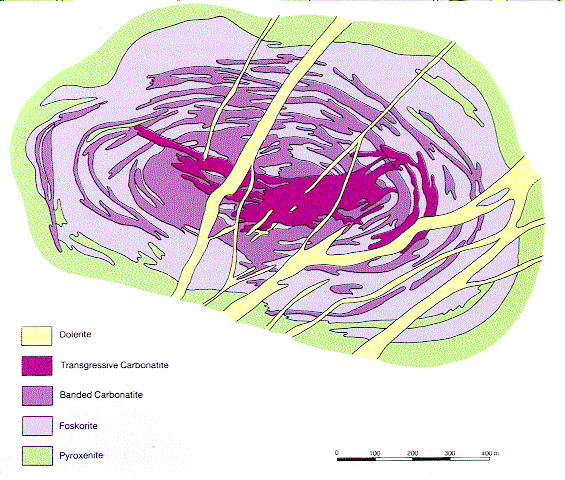To log this EarthCache you need to answer the following questions and email it to me.
1. At the viewpoint, what is the elevation according to your GPS.
2. Describe any veins you see in the rocks on the pit wall on the other side of the hole.
3. Describe the colours of the different rocks you see on the ground at the viewpoint.
4. Uploading photos to the cache page and adding a favorite point is some of the best ways to say thank you to the cache developer and to encourage others to visit the location but is only optional.
You can send your answers to me in either Afrikaans or English.
Geology and History of the mine.
The Phalaborwa Complex consists of a central bony of ultrabasic rocks surrounded by numerous plugs of syenite and is 2030 (+- 18) million years old. The pyroxenite body (which probably represents the remains of a volcanic vent) encloses three areas of ultrabasic pegmatite. Copper with the co-products of silver, gold, phosphate, iron ore, vermiculite, zirconia and uranium are extracted from the rocks.
The Complex is unique when compared to other African alkaline complexes, because its carbonatite components contain copper ore. Magnetite, uraninite-thorianite and baddeleyite are subsidiary product of the copper mining. The ultramafic rocks of the complex also contain economic deposits of apatite and vermiculite. Large numbers of younger dolerite dykes intrude and cut all of the rocks of the complex, and it is in these that zeolitic mineralisation occurs.
The geology of the mine (a volcanic plug) is extremely complex. Besides various rock types (up to ten types at the mine) with different properties, there are four main faults crossing the pit and 3 dominant joint sets ubiquitous in the mine. Ground water is also present.

Palabora mine has been in operation since it was incorporated in 1956 and is South Africa's only producer of refined copper. During the 1960s, 1970s and 1980s, the company's open-pit copper mine and associated processing plants produced over 2,7 million tons of copper. Palabora is listed in the JSE. Producing about 60,000 tonnes of refined copper per year, the company supplies most of South Africa's copper needs and exports the balance.
Palabora mine is one of the steepest and deepest large open pits in the world, with a radius of about 1.5 km, and a depth of about 800 m. The bottom of the opencast pit is presently around 230 meters below sea level.
The company owes its origin to the unique formation known as the Palabora Igneous Complex. Nowhere else is copper known to occur in carbonitites as is the case at Palabora, and a host of other minerals such as phosphates, vermiculite, phlogopite, magnetite, nickel, gold, silver, platinum and palladium also occur.
Palabora mine operates a large block cave copper mine and smelter complex employing approximately 2200 people. The refinery produces continuous cast rod for the domestic market and cathodes for export. Useful byproduct metals and minerals include zirconium chemicals, magnetite and nickel sulphate as well as small quantities of gold, silver and platinum. Palabora has developed a US$410 million underground mine with a production capacity of 30,000 tonnes of ore per day.
Palabora also owns a nearby vermiculite deposit which is mined and processed for sale worldwide. Vermiculite is a versatile industrial mineral with hundreds of uses.

History of Palabora
Some two billion years ago, a series of violent volcanic eruptions, which took place over a period of millions of years, gave rise to a rich body of minerals, which became known as the Palabora Igneous Complex. The unique ore body outcropping at a small saddleback hill, later to be called Loolekop, contains a unique variety of minerals - copper, phosphates, magnetite, uranium, zirconium, nickel, gold, silver, platinum, and palladium. Two other volcanic pipes nearby contain vermiculite and phosphate.
Smelting of copper iron occurred in the district prior to the discovery. We know from the artifacts found in the area, that copper of remarkable purity was produced in the Phalaborwa area as early as the 8th century. Development of modern mining activity started at the beginning of the century when several geologists in the noted the occurrence of the phosphate bearing mineral, apatite, in the vicinity of Loolekop.
Source:
http://www.palabora.com/palabora.asp
